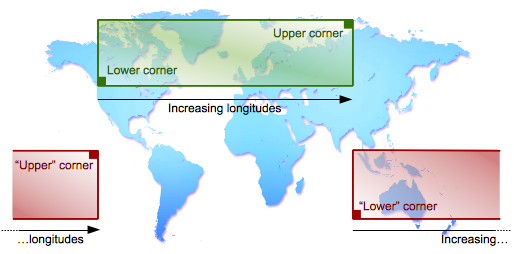Package org.apache.sis.geometry
package org.apache.sis.geometry
Basic geometric objects (envelopes and direct positions). Every geometry objects are associated
with a Coordinate Reference System,
which may have an arbitrary number of dimensions. However, a few specialized classes restrict
the CRS to a fixed number of dimensions only. The table below summarizes the most common
objects, and list the Java2D classes that are conceptually equivalent.
 In SIS, every envelopes defined in this package support the extended bounding box interpretation:
for any dimension, coordinate values such that upper < lower are handled
in a special way. This handling is slightly different for two groups of methods:
In SIS, every envelopes defined in this package support the extended bounding box interpretation:
for any dimension, coordinate values such that upper < lower are handled
in a special way. This handling is slightly different for two groups of methods:
| Purpose | Any dimension | One dimension | Two dimensions | Java2D equivalence |
|---|---|---|---|---|
| A point in a multi-dimensional space | GeneralDirectPosition |
DirectPosition1D |
DirectPosition2D |
Point2D |
| A box in a multi-dimensional space | GeneralEnvelope |
Envelope2D |
Rectangle2D |
Java2D dependency
All classes having a name that ends with "2D" are designed for inter-operability with Java2D. All other classes have no dependency to Java2D. This clear separation aims to make easier to use Apache SIS on platforms that do not support Java2D (for example Android) or to avoid loading Java2D classes when only JavaFX is desired.Envelopes crossing the anti-meridian of a Geographic CRS
The Web Coverage Service (WCS) 1.1 specification uses an extended interpretation of the bounding box definition. In a WCS 1.1 data structure, the lower corner defines the edges region in the directions of decreasing coordinate values in the envelope CRS, while the upper corner defines the edges region in the directions of increasing coordinate values. Those lower and upper corners are usually the algebraic minimum and maximum coordinates respectively, but not always. For example, an envelope crossing the anti-meridian could have a lower corner longitude greater than the upper corner longitude, like the red box below (the green box is the usual case):
- In calculation of envelopes spans and median positions (centers) — handled specially only
on axes having the
WRAPAROUNDrange meaning. - When checking for containment, intersections or unions — can be handled specially for any axis, in which case the envelope represents an exclusion area instead than an inclusion area.
- Since:
- 0.3
- See Also:
-
ClassDescriptionDefault implementations of some
DirectPositionmethods, leaving the data storage to subclasses.Default implementations of mostEnvelopemethods, leaving the data storage to subclasses.Formats spatiotemporal coordinates using number, angle and date formats inferred from the coordinate system.A one-dimensional position within some coordinate reference system.A two-dimensional position on top of Java2D point.A two-dimensional envelope on top of Java2D rectangle.Transforms envelopes to new Coordinate Reference Systems, and miscellaneous utilities.A mutableDirectPosition(the coordinates of a position) of arbitrary dimension.A mutableEnvelope(a minimum bounding box or rectangle) of arbitrary dimension.An immutableEnvelope(a minimum bounding box or rectangle) of arbitrary dimension.Indicates that an object cannot be constructed because of a mismatch in the reference systems of components.Utility methods working on Java2D shapes.Indicates that an operation is not allowed on a geometry object because it is unmodifiable.An envelope or position converter making them more compatible with a given domain of validity.The strategy to use for representing a region crossing the anti-meridian or other wraparound limit.